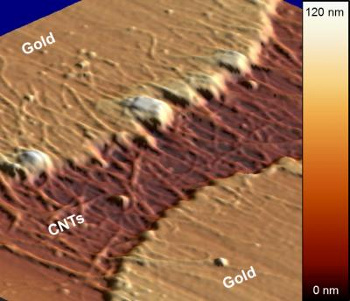Electromigration
September 12, 2011
As I've found in the transition from bulky,
vacuum tube electronics, such as
televisions,
radios and
sound systems, to the lightweight and compact units sold today, going small has many benefits. Unfortunately, these benefits didn't come until after my nomad days when it seemed that I was moving my household on an annual basis.
Smaller electronics may benefit the consumer, but there are quite a few technical issues involved in
miniaturization. One of these is
electromigration.
No matter the size of the
audio player, you still need to produce the same
power at the listener's ear, or your device won't sell. For the
personal players, this is easy, since you just concentrate the audio in small
earphones. Home entertainment systems, however, still need to pump tens of
watts into
loudspeakers. All this results in high
currents on the
conductors inside
integrated circuits.
When these current-carrying conductor traces are thin in both thickness and width, the
cross-sectional area of these conductors become very small. At a given current, the current density becomes extremely large. Although we don't really associate electrical current with movement, current is the movement of
electrons, and these electrons do run into some resistance in the conductors. Otherwise, we would have a
superconductor, and not the mundane
aluminum,
copper or
gold in our integrated circuits.

Michael Faraday, c. 1867.
The Faraday constant is the magnitude of electric charge of one mole of electrons. The unit of electrical current, the ampere, is the flow of 6.241 x 1018 electrons (a coulomb) per second, or a little more than 1 x 10-5 Faradays per second.
(Via Wikimedia Commons))
An electron in a conductor, when it meets resistance in the
metal lattice, imparts a
momentum against the resistance, effectively pushing
atoms out of the way. The effect is very small on a per electron basis, but at high
current densities, things start to add up. Gaps will actually open in thin conductors as enough atoms are pushed out of the way by electrons.
Fortunately,
materials scientists know a few tricks, one of which is that the addition of small amounts of copper to aluminum, which
mechanically hardens it, increases its current handling capacity by many times. There's
no free lunch, so copper addition does reduce the conductivity of aluminum. Electromigration doesn't happen in
semiconductors, but a
heavily-doped semiconductor behaves like a metal, and these are susceptible to electromigration.
There has been much interest in using
carbon nanotubes in integrated electronics, so the question naturally arises as to what electromigration effects might be seen in carbon nanotube circuitry. That's what a team from the
US National Institute of Standards and Technology (NIST) investigated, and they discovered some
reliability issues that are partially explained by electromigration.[1-3]
The NIST team fabricated circuits in which carbon nanotube arrays connected gaps in metal electrodes. They found that the nanotubes are good current carriers that sustain extremely high current densities. The supported current densities were one- to two-orders of magnitude greater that those found in a typical integrated circuit. These current densities were supported for several hours, but they slowly degraded. The initial current densities were as high as ten
mega-
ampere per
square centimeter![3]
Those currents must pass also through the metalization, also, and that demonstrated another problem. The metal electrodes failed. The edges of the metalization receded and clumped, as shown in the
micrograph below. The combined carbon-nanotube-metal conductors failed after times up to about 40 hours.[1]

Micrograph of recession and clumping in gold electrodes after application of 1.7 volts to the carbon nanotubes for an hour.
(Image: M. Strus/NIST).[1])
The NIST data also showed a way to predict which circuits would fail early, and which would continue conducting current for a longer period. The NIST team found that the initial
resistance was a predictor of total device lifetime.[3] Their electron microscopy studies indicated that variability in the fabrication of the circuits was an important factor in the rate of degradation. Well-fabricated conductors under constant current conditions showed a linear accumulation of damage reminiscent of electromigration.
Oxygen and
water desorption are suspected to be further contributing factors in degradation, but this mechanism could not be confirmed.[3]
While I was in
graduate school, I worked alongside a team that investigated electromigration in the exotic materials, ZrPt
3 and HfPt
3.[4] These alloys are highly stable
intermetallic compounds. ZrPt
3, has an
enthalpy of formation (ΔH
f) of -124
kcal/
mole and a
melting point of about 2400
K (3850 °
F). HfPt
3 has an enthalpy of formation (ΔH
f) of -132 kcal/mole and the same melting point.[5] These metals have tightly-bonded atoms that would not be expected to easily migrate. I wrote about these alloys in a
previous article (Krell metal, August 31, 2006).
References:
- Laura Ost, "NIST uncovers reliability issues for carbon nanotubes in future electronics," National Institute of Standards and Technology Press Release, August 17, 2011.
- Mark C. Strus, Robert R. Keller and Nicholas Barbosa, "Electrical Reliability and Breakdown Mechanisms in Single-Walled Carbon Nanotubes," Paper WeP1T1.2 of the IEEE Nano 2011 Conference (Portland, Ore.), Aug. 17, 2011.
- Mark C Strus, Ann N Chiaramonti, Young Lae Kim, Yung Joon Jung and Robert R Keller, "Accelerated reliability testing of highly aligned single-walled carbon nanotube networks subjected to DC electrical stressing," Nanotechnology, vol. 22 (2011), Document No. 265713
- L. M. Pecora and P. J. Ficalora, "Some bulk and thin film properties of ZrPt3 and HfPt3," Journal of Electronic Materials, vol. 6, no. 5 (September, 1977), pp. 531-540
- V. Srikrishnan and P.J. Ficalora, "Measurement of the enthalpies of formation of ZrPt3 and HfPt3 by fluorine bomb calorimetry," Metallurgical Transactions, vol, 5, no. 6, (June, 1974). pp.1471-1475.
Permanent Link to this article
Linked Keywords: Vacuum tube; electronics; television; radios; high fidelity sound system; miniaturization;electromigration; audio amplifier; audio player; power; portable media player; earbud; earphone; watt; loudspeaker; electric current; electrical conductor; integrated circuit; cross-sectional area; electron; superconductor; aluminum; copper; gold; Michael Faraday; Faraday constant; mole; ampere; coulomb; Wikimedia Commons; metal; crystal; lattice; momentum; atom; current density; materials scientist; strengthening mechanisms of materials; no free lunch; semiconductor; heavily-doped; carbon nanotube; US National Institute of Standards and Technology; NIST; reliability;mega-ampere; square centimeter; micrograph; electrical resistance; oxygen; water; desorption; graduate school; intermetallic compound; enthalpy of formation; kcal/mole; melting point; Kelvin; Fahrenheit; Krell metal.